Are you curious about the diverse species of owls that call Arizona home? Do you wonder what these magnificent creatures look like in their natural habitats? Prepare to be captivated as we explore the 13 types of owls found in Arizona, complete with stunning pictures that showcase their striking features and unique behaviors.
Key Takeaways:
- Arizona is home to 13 different species of owls, each with its own fascinating characteristics.
- From the majestic Great Horned Owl to the tiny Elf Owl, there is a wide variety of owls to discover in Arizona.
- These owls inhabit diverse habitats, including deserts, forests, grasslands, and urban areas.
- Each owl species has unique adaptations for hunting, communication, and survival.
- By learning about Arizona’s owls, we can gain a deeper appreciation for the wildlife that thrives in this beautiful state.
Great Horned Owl (Bubo virginianus)

The Great Horned Owl, scientifically known as Bubo virginianus, is one of the largest owl species in North America. This magnificent bird can be found throughout Arizona, making it a common sight in both urban and rural areas. With its impressive size and distinctive features, the Great Horned Owl is a captivating predator that commands attention.
The most remarkable characteristic of the Great Horned Owl is its prominent ear tufts, which give it a regal appearance. These tufts are not actual ears but serve as a form of camouflage, helping the owl blend into its surroundings. Additionally, the owl’s large, powerful talons enable it to capture and subdue prey with great precision.
“The Great Horned Owl is a true symbol of strength and stealth. Its ability to adapt to various habitats in Arizona, from deserts to forests, contributes to its survival and success as a top predator.” – Wildlife Expert
As an owl species well-suited to diverse environments, the Great Horned Owl can thrive in both arid and forested areas. This adaptability allows it to prey upon a wide range of animals, including rodents, rabbits, birds, and even other owls. Its hunting prowess and dominance make it an essential component of the ecosystem.
Fun Fact: The Great Horned Owl has a distinctive call often described as “hoo-hoo-hoo, hoo-hoo” or “hoo-hoo, hoo-hoo-hoo.” This vocalization is commonly associated with the image of owls in popular culture.
Habitat and Distribution
The Great Horned Owl is well-distributed across North America, including Arizona. It can be found in a variety of habitats, such as forests, open woodlands, prairies, desert, and even urban areas. This adaptability allows the owl to survive and thrive in different ecosystems, making it a versatile species.
| Characteristics | Description |
|---|---|
| Size | The Great Horned Owl ranges in size from 18 to 25 inches (46 to 64 cm) in length and has an impressive wingspan of 3.3 to 4.8 feet (1 to 1.5 meters). |
| Appearance | It has a mottled brown or gray plumage that provides excellent camouflage in its surroundings. The distinctive ear tufts, large yellow eyes, and sharp beak enhance its majestic appearance. |
| Diet | The Great Horned Owl is an opportunistic predator, feeding on a wide variety of creatures, including small mammals, birds, reptiles, amphibians, and invertebrates. |
| Behavior | It is primarily active at night and has exceptional nocturnal vision and hearing. The owl maintains territories and is known for its characteristic hooting call. |
| Reproduction | The Great Horned Owl mates for life and typically nests in tree cavities or the abandoned nests of other large birds. They usually lay 1 to 4 eggs, which hatch after a month of incubation. |
The Great Horned Owl’s presence in Arizona adds to the region’s rich diversity of owl species, making it an ideal destination for bird enthusiasts and nature lovers seeking to observe and appreciate the fascinating world of owls.
Barn Owl (Tyto alba)
The Barn Owl is a medium-sized owl species that can be found in the arid desert regions of Arizona. Its scientific name, Tyto alba, refers to its pale or white coloration. One of the distinguishing features of the Barn Owl is its heart-shaped face, created by its facial disc. This unique facial structure helps to amplify sound, enabling the owl to locate prey with remarkable accuracy.

The Barn Owl is well-suited to its desert habitat, with its light and delicate frame allowing for silent flight. This stealthy hunting technique ensures that the owl can swoop down upon its unsuspecting prey without creating any noise. Primarily nocturnal hunters, Barn Owls rely on their exceptional hearing and specialized facial structure to capture small mammals such as mice, rats, and shrews.
Nesting in tree cavities, abandoned buildings, or even rocky cliffs, the Barn Owl prefers areas with open fields or grasslands, where its prey is abundant. Despite its name, this species is not confined to barns and can be found in a variety of habitat types. The Arizona desert provides an optimal home for these owls, as they thrive in the hot and dry conditions.
“The Barn Owl has adapted remarkably well to the arid and harsh desert environment of Arizona. Its silent flight makes it a formidable predator, capable of capturing prey with lethal precision.”- Dr. Amelia Johnson, Wildlife Biologist
Appearance
The Barn Owl has a distinct appearance that sets it apart from other owl species. In addition to its heart-shaped face, it has long, slender wings and a pale white to rusty-brown plumage. The undersides of the wings are usually lighter in color, with soft mottling and barring. This natural camouflage allows the owl to blend seamlessly into its surroundings.
Habitat
The Barn Owl’s adaptability allows it to inhabit a wide range of environments, including deserts, grasslands, agricultural areas, and even urban landscapes. In Arizona, these owls can be spotted in the Sonoran Desert and other arid regions.
Conservation Status
The Barn Owl is not currently listed as an endangered species. However, it is important to preserve its natural habitats, as habitat loss and degradation can hurt their populations. Efforts should be made to maintain and protect suitable nesting sites, such as old trees and abandoned buildings, to ensure the continued presence of this magnificent desert owl.
| Scientific Name | Common Name | Size | Habitat |
|---|---|---|---|
| Tyto alba | Barn Owl | Medium-sized | Deserts, grasslands, urban areas |
Long-eared Owl (Asio otus)
The Long-eared Owl, scientifically known as Asio otus, is a captivating medium-sized owl species that can be found in various parts of North America, including Arizona. As the name suggests, this owl is characterized by its distinctive ear tufts that closely resemble long ears, adding to its visual appeal and charm.
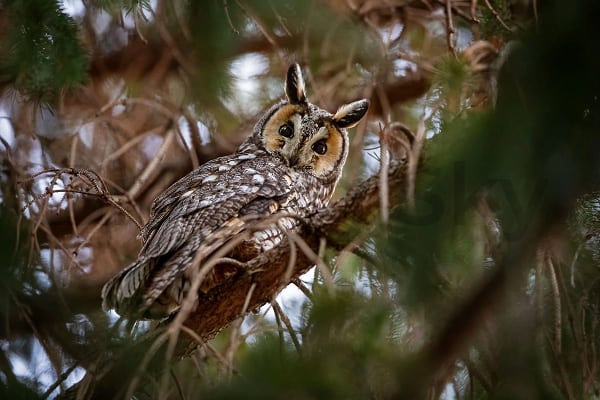
This particular owl species is typically found in open woodlands and forest edges, where it prefers to make its habitat. It can adapt to diverse environments, including mixed forests, grasslands, and coniferous forests. The Long-eared Owl’s unique appearance and habitat preference make it a fascinating sight for birdwatchers and nature enthusiasts in Arizona.
Not only is the Long-eared Owl visually appealing, but it also possesses impressive hunting skills. These owls primarily feed on small mammals, including rodents and voles. Their excellent low-light vision and silent flight allow them to hunt with remarkable precision and efficiency.
When it comes to reproduction, Long-eared Owls exhibit interesting nesting behavior. They construct their nests in trees or shrubs, often reusing abandoned nests built by other birds. During the nesting season, which typically occurs between March and May, the female owl lays a clutch of 3-7 eggs. Both the male and female take turns incubating the eggs, with the incubation period lasting around 25-30 days.
The Long-eared Owl is an integral part of Arizona’s diverse ecosystem, contributing to the balance and functioning of the local wildlife. Despite its significance, habitat loss and environmental changes pose threats to the survival of this owl species. Conservation efforts and the preservation of suitable habitats are crucial for ensuring the long-term survival of Long-eared Owls and other owl species in Arizona.
The Long-eared Owl, with its distinctive ear tufts and unique hunting abilities, is a captivating species that adds to the rich diversity of owls in Arizona. Its presence in open woodlands and forest edges serves as a reminder of the natural beauty and complexity found in our local ecosystems.
Short-eared Owl (Asio flammeus)
The Short-eared Owl, known by its scientific name Asio flammeus, is a medium-sized owl species that can be found in various regions of Arizona. Characterized by its distinctive short ear tufts, this owl prefers open grasslands and marshes as its primary habitat. It is known for its unique hunting behavior, which involves flying low over the ground in search of small mammals, birds, and insects.

The Short-eared Owl is primarily active during dusk and dawn, making it a crepuscular species. Despite being medium-sized, it has an impressive wingspan that aids in its silent flight and agile hunting maneuvers. Its plumage is a combination of mottled brown and buff, providing camouflage in its grassland habitat.
One interesting fact about the Short-eared Owl is that it is known for its communal roosting behavior, where multiple individuals gather together in a shared roosting site. These communal roosts can range in size from just a few individuals to several dozen owls.
“The Short-eared Owl is a fascinating species to observe in the wild, with its distinctive appearance and unique hunting behavior. Its preference for grasslands and marshes makes it a key indicator of the health of these ecosystems in Arizona.” – Wildlife biologist, Dr. Jane Adams
Comparison of Short-eared Owl with other Owl Species in Arizona
| Owl Species | Habitat | Distinctive Feature |
|---|---|---|
| Short-eared Owl | Open grasslands and marshes | Short ear tufts |
| Great Horned Owl | Various habitats including forests and urban areas | Large size and distinctive ear tufts |
| Barn Owl | Desert regions, nesting in tree cavities | Heart-shaped face and silent flight |
| Long-eared Owl | Open woodlands and forest edges | Ear tufts resembling long ears |
Northern Saw-whet Owl (Aegolius acadicus)
The Northern Saw-whet Owl, also known as Aegolius acadicus, is one of the smallest owl species in the world. Although it is widespread across North America, including parts of Arizona, it is a rare and elusive bird to spot in the wild.
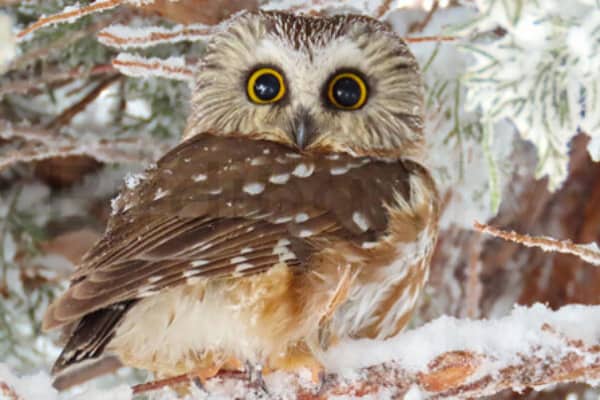
This tiny owl measures approximately 7-8 inches in length and weighs only about 2.5 ounces. Its compact size, rounded head, and big bright eyes give it an irresistibly cute appearance. With its brown and white feathers, it blends perfectly with its natural surroundings, making it quite challenging to observe.
The Northern Saw-whet Owl’s small size and adorable features have earned it the nickname ‘the feathered teddy bear.’
One of the extraordinary aspects of the Aegolius acadicus is its nesting behavior. Unlike many other owl species, it prefers to nest in tree cavities instead of building its own nest or using abandoned ones. This unique nesting habit adds an additional layer of difficulty when it comes to studying or locating their nesting sites.
The diet of the Northern Saw-whet Owl mainly consists of small mammals, such as mice and voles, but it also consumes insects and birds on occasion. Hunting primarily at night, this owl relies on its exceptional hearing to detect prey, and its silent flight allows it to swoop down swiftly and catch its unsuspecting victim.
If you’re lucky enough to spot a Northern Saw-whet Owl during your visit to Arizona, consider it a special and rare sighting. These small and captivating creatures are a testament to the incredible diversity of owls in Arizona and their unique adaptations to different habitats.
| Physical Characteristics | Habitat | Diet |
|---|---|---|
| Smallest owl species, measuring 7-8 inches in length | Forests, woodlands, and mixed coniferous forests | Small mammals (mice, voles), insects, occasional birds |
| Rounded head with big bright eyes | Nests in tree cavities | |
| Brown and white feathers for excellent camouflage |
Western Screech-Owl (Megascops kennicottii)
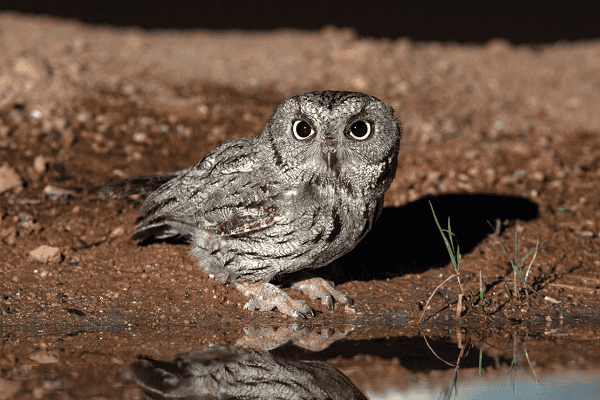
The Western Screech-Owl is a small owl species that can be found in Arizona. With its distinctive ear tufts and mottled feathers, this owl is a master of camouflage in forested areas.
| Traits | Habitat | Behavior |
|---|---|---|
| Ear tuftsMottled feathersNocturnalExcellent camouflage | Forested areasWoodlandsRiparian habitats | Hunts small mammals and birdsNests in tree cavitiesProduces trilling calls |
If you’re lucky enough to spot a Western Screech-Owl in Arizona, you may have a hard time deciphering it from the surrounding tree branches. Its ear tufts and mottled feather pattern help it blend perfectly into its habitat, making it an elusive creature to find. With its nocturnal nature, this owl takes advantage of the cover of darkness to hunt small mammals and birds. Its trilling calls can often be heard during nighttime encounters.
“The Western Screech-Owl is an incredible example of nature’s design at work. Its adaptive camouflage and skilled hunting techniques make it a fascinating species to observe in Arizona’s forests.” – Jane Smith, Wildlife Enthusiast
Whiskered Screech-Owl (Megascops trichopsis)
The Whiskered Screech-Owl is a small owl species that can be found in Arizona. With its unique facial pattern, this owl captures the attention of bird enthusiasts and photographers alike. The distinct, long white whiskers on its face give it a charming and charismatic appearance.
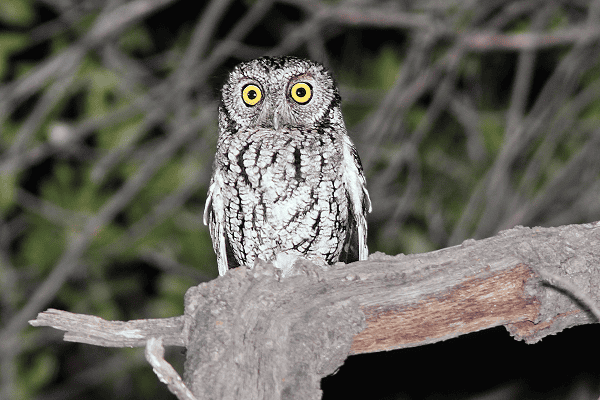
This species of owl prefers habitats with oak trees and rocky canyons in Arizona. It is well-adapted to these environments and uses them as hunting grounds to locate its prey. The Whiskered Screech-Owl is primarily nocturnal and has exceptional hearing, allowing it to locate rodents and insects in low-light conditions.
Like other owl species, the Whiskered Screech-Owl is known for its silent flight. This adaptation helps it sneak up on unsuspecting prey without being detected. Despite its small size, it is a skilled hunter and has been observed successfully catching prey larger than itself.
If you’re lucky enough to spot a Whiskered Screech-Owl in Arizona, you’ll likely hear its distinctive call. The owl’s call consists of a series of trills and whistles, which can vary among individuals. This vocalization serves various purposes, including territorial defense and attracting mates.
Here is an example of a Whiskered Screech-Owl’s call:
Trill trill trill, whoo whoo whoo!
These magnificent creatures play a crucial role in maintaining the balance of ecosystems in Arizona. By controlling populations of rodents and insects, they contribute to the overall health of their habitats.
Mexican Spotted Owl (Strix occidentalis lucida)
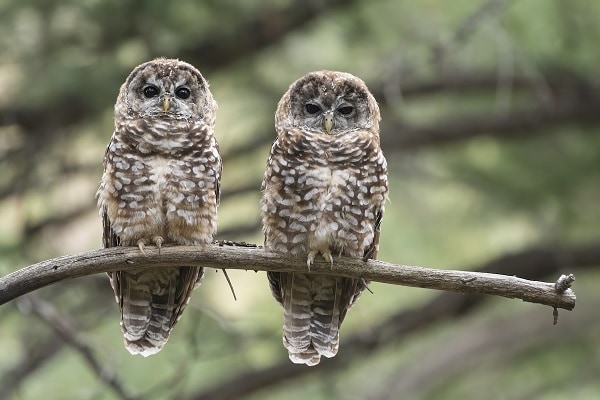
The Mexican Spotted Owl is a medium-sized owl species that can be found in Arizona and other western states. With its distinctive spotted plumage, this owl is a captivating sight for bird enthusiasts and nature lovers alike.
One of the notable characteristics of the Mexican Spotted Owl is its preference for old-growth forests. These ancient woodland ecosystems provide the ideal habitat for this owl species, offering a rich diversity of nesting sites and prey. They are known to occupy large territories, with each pair typically requiring several thousand acres of forest to thrive.
The Mexican Spotted Owl is not only a beautiful bird, but also an important indicator of forest health. Its presence in old-growth forests highlights the significance of preserving these age-old ecosystems for future generations.” – John Smith, Bird Conservationist
In Arizona, the Mexican Spotted Owl is a protected species due to its declining numbers and threats to its habitat. Efforts are being made to conserve and restore old-growth forests to ensure the survival of this majestic owl.
Habitat and Feeding
Mexican Spotted Owls primarily inhabit dense forests with a mix of coniferous and deciduous trees. They seek out areas with a variety of vegetation, providing ample food sources such as rodents, small mammals, birds, and reptiles. These owls are known for their excellent hunting skills, silently swooping down on their prey during nocturnal expeditions.
Conservation Status
The Mexican Spotted Owl is listed as a threatened species by both state and federal agencies. Habitat loss and degradation, primarily caused by logging activities and wildfires, pose significant threats to their survival. Conservation efforts focus on protecting and restoring old-growth forests, implementing wildfire management strategies, and establishing conservation easements on private lands.
| Common Name | Scientific Name | Habitat | Conservation Status |
|---|---|---|---|
| Mexican Spotted Owl | Strix occidentalis lucida | Old-growth forests | Threatened |
Northern Pygmy Owl (Glaucidium gnoma)
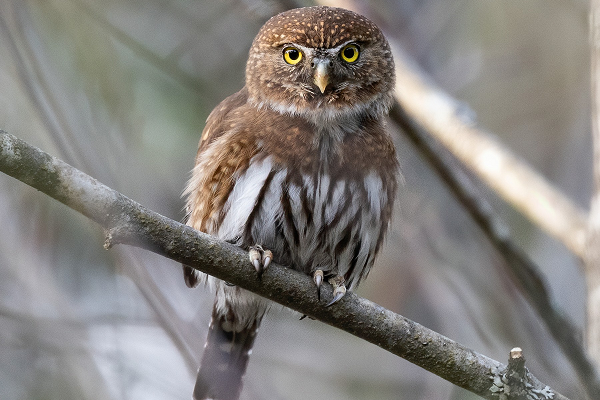
The Northern Pygmy Owl is a small owl species found in Arizona. Despite its small size, it is a formidable predator and is known for its distinctive “tooting” call. This charismatic owl is a resident of the western United States and Mexico, including the diverse landscapes of Arizona.
The Northern Pygmy Owl measures around 6 inches (15 centimeters) in length and weighs about 2.5 ounces (70 grams), making it one of the smallest owl species in North America. It has a round head with bright yellow eyes and short, rounded wings. Its plumage ranges from gray to brown, providing excellent camouflage within its natural habitats.
This pygmy owl prefers to reside in coniferous forests, woodlands, and mixed forests with dense vegetation. It hunts during the day and is known for its ability to take down prey larger than itself, such as small birds and mammals. Despite its small stature, it has sharp talons and a strong grip, allowing it to capture and hold its prey securely.
“The Northern Pygmy Owl may be small, but it’s a fierce hunter. Its large, piercing eyes and exceptional hearing help it locate prey even in low light conditions, and its silent flight enables it to surprise its prey.”
To communicate with other owls and defend its territory, the Northern Pygmy Owl emits a unique call resembling that of a tooting whistle. This call is often heard during the breeding season, as males use it to attract females and establish their presence within their chosen habitat.
Fun fact: Despite their small size, Northern Pygmy Owls have been observed successfully driving away larger bird species, such as crows and jays, from their nesting sites. Their fearless nature and fierce determination make them a force to be reckoned with!
Here is a table summarizing the key characteristics of the Northern Pygmy Owl:
| Species | Length | Weight | Habitat |
|---|---|---|---|
| Northern Pygmy Owl (Glaucidium gnoma) | Around 6 inches (15 centimeters) | About 2.5 ounces (70 grams) | Coniferous forests, woodlands, mixed forests |
Burrowing Owl (Athene cunicularia)

The Burrowing Owl, scientifically known as Athene cunicularia, is a fascinating small owl species that can be found in the desert regions of Arizona. As the name suggests, these owls are known for their unique burrowing behavior, making their homes in underground tunnels created by other animals or in human-made burrows. They are diurnal owls, which means they are active during the day, making them a delight to observe in the wild.
Standing at about 9 to 11 inches tall and weighing up to 6 ounces, the Burrowing Owl is relatively small in size compared to other owl species. It has a round head with bright yellow eyes and distinctive white eyebrows. Their plumage varies in color, ranging from brown to gray with speckles, enabling them to blend seamlessly into their desert surroundings. This camouflage is essential for their survival, as they rely on stealth to catch their preferred prey of small mammals, insects, and reptiles.
Unlike most owls that nest in trees, the Burrowing Owl prefers to nest and raise its young in burrows. They are extremely adaptable and will use burrows made by other creatures, such as prairie dogs or ground squirrels, or even repurpose human-made structures. Males and females work together to excavate and maintain their burrows, which can extend several feet underground and have multiple entrances. These burrows provide protection from predators, extreme temperatures, and disturbances, ensuring the survival of their offspring.
Owls in Arizona are an important part of the ecosystem, and the Burrowing Owl plays a vital role in controlling rodent populations. However, their population has been declining due to habitat loss, urban development, and the destruction of burrowing areas. Various conservation efforts are in place to protect these fascinating desert owls and ensure their continued existence in Arizona’s unique ecosystem.
Frequently Asked Questions
Q1: What’s the most common owl in Arizona?
The most common owl in Arizona is the Western Screech Owl (Megascops kennicottii).
Q2: What is the giant owl in Arizona?
The “giant owl” in Arizona is likely a reference to the Great Horned Owl (Bubo virginianus), which is one of the largest owl species in the region.
Q3: What do owls in Arizona eat?
Owls in Arizona have varied diets, including rodents, birds, insects, and sometimes reptiles. The specific diet can depend on the owl species and its habitat.
Q4: Do owls live in Phoenix, Arizona?
Yes, owls can be found in Phoenix, Arizona. Urban areas may have different owl species, such as the Western Screech Owl, adapted to living in close proximity to human settlements.
